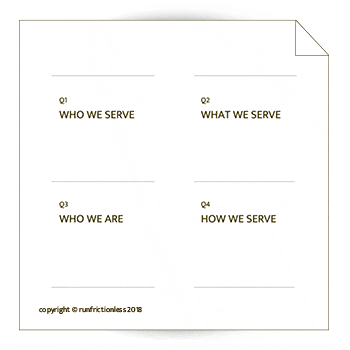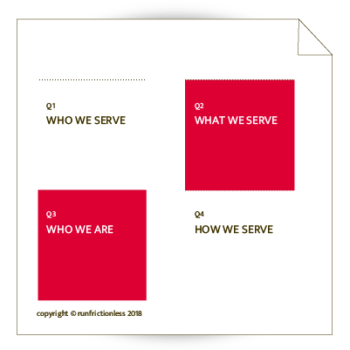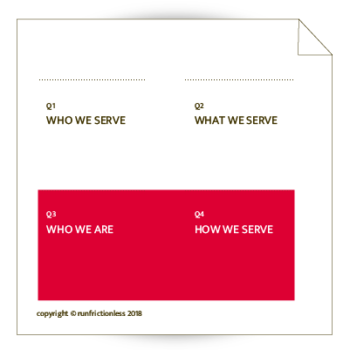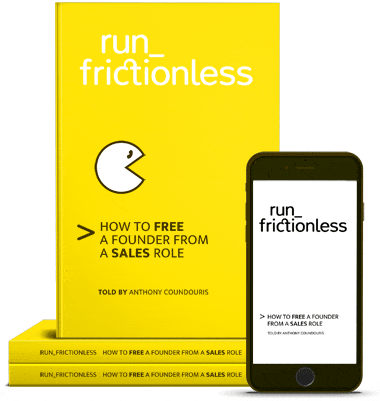
Who you are and how you serve: Ethan Beute podcast
>
Who you are and how you serve 🎙️ Ethan Beute podcast
I caught up with the Customer Evangelist from Bomb Bomb, Ethan Beaute, in 2021.
This was the second time Ethan interviewed me. It was just as exciting as the first time I appeared on his cast, The Customer Experience, a year ago. run_frictinonless are supporters and users of personal video. If you’d like to understand how to deliver personal video to your customers, tune into this cast of The Customer Experience and check out BombBomb’s website.
Now, on with the show!
ETHAN’S SPEIL
When you present who you are — your core beliefs — to the customer, do you get head nods, indifference, or 😖 hostility? All 3 are great responses, actually. If they’re nodding, they probably share your beliefs. That’s a key tenet of quadrant 3: who we are.
In this episode, I interview return guest Anthony Coundouris, author of the book run_frictionless, about how Quadrant 3 (who we are) and Quadrant 4 (how we serve) fit in the overall 4-part frictionless framework.
Anthony and I also talked about:
q. Define “customer experience”

What does it feel like to become a customer of your business? Creating a good or bad experience is not the focus. What is the kind of experience you want to create, that projects the right beliefs from the moment of contact with a customer. That’s what matters.
q. What types of businesses have you been working with?

50% of firms are pre-revenue. The balance is businesses running for 5 years or more. The former is using our framework to get revenue. Whereas established companies are using it as a means of scaling their business owner or sales leaders.
q. Run us quickly through the 4Qs
The 4Qs (short for Four Quadrants) is a decision-making framework.
The power of the 💪4Qs rests in how it organizes people and processes into one or more quadrants, such that everyone in the business has a clear picture of how their role and decisions touch a customer.
What I realized early in my career was that sales are not the responsibility of the salespeople, it is an organizational goal. What you quickly find with the 4Qs is that it pulls together the entire organization to get behind the salespeople, so the salespeople become the tip of the iceberg.
If I was to provide a summary of each of the Four Quadrants:

q. Explain why Quadrants 3 and 4 are defensible but difficult to operationalize

Sharing beliefs sets in motion a set of irrational buying forces that are near impossible for a competitor to mimic. The irrational buying force is so strong, that even when sales, product, and operations people are screwing up, customers keep buying because they believe in the brand.
Do you remember this quote from the book?

Anybody can have a belief, vision, or mission statement. The value is whether your staff, shareholders, and customers 🙌 share your belief, vision, or mission statement.
The reason they are so defensible is that beliefs are inside-out. The business leader who is building a Quadrant 1-3 fit is addressing the churn in their customer base and staff.
Sharing beliefs will gather people to your cause. Customers, staff, and shareholders will stand with you, talk and share the belief as though it was theirs. Because it is theirs.
Operationalizing this is not easy. This is why so many beliefs are insincere. They are created by an advertising agency and plastered on billboards. They are real and they are shared between the founder, staff, and the customer.
q. Talk a little about “fit” between the Quadrants

A big influence for the development of the 4Qs framework came from Marc Andreessen, cofounder of Netscape who coined the idea ‘product-market fit’.
For a lot of us, ‘fit’ was a light bulb moment. What made his metaphor so brilliant was that rather than thinking of building a business as a step 1, 2, 3, Marc is saying it is 1, 2 then 1, and then 2, and then 1 again.
While I like this metaphor of ‘fit’, however, product-market is a little too broad and I needed something more granular.
The 4Qs encourages users to ‘play’ or ‘fit’ 🕹 one quadrant with another. Today, we have identified at least eight kinds of plays or fits that one can make using the 4Qs.

q. Let’s focus on Quadrant 3 — who we are

Have you ever worked in an organization where its customers and staff do not share your beliefs? Tony Hsieh, in his book Delivering Happiness, tells a story about why he sold his first business to Microsoft.
Tony describes how he hated 👎 coming to the office each day because he was surrounded by staff and customers who did not share his beliefs. While Tony did well financially his motivation for selling was to divest himself of a company without beliefs.
In his own words:

Can you imagine going to your own business, and feeling ostracized? Marc Andreessen believes HR people amplify shared beliefs. He had this to say on the topic of culture and beliefs:
q. What bearing does the 4Qs have on customer conversion and retention?

A sale is a battle ✊👊 of beliefs before it is a battle over product.
The first 5 slides were dedicated to the belief we share. The belief is the problem we identified and our unique approach to solving it. There’s no product here.
I’m not espousing ruthlessness. Only sanity. The people who do not share your belief cannot change them. The conversion rate is only 3% and it is too expensive. As early as possible, test whether you have a Quadrant 1-3 fit with a prospect. If you don’t, politely escort them from your sales funnel.
q. Explain why there is no space for “vanity values”

Firstly, include only values that return value to a profile in Quadrant 1. Remember, we don’t serve everyone and therefore, we don’t need to empathize with everyone.
Secondly, for each value you espouse, you need one interaction from Quadrant 4 to demonstrate that specific value. The company must be prepared to ☝invest dollars. Without an investment in Quadrant 4, organizations have vanity values.
If you are consulting with either your own organization or a client, one way to rein in their list of values is to ask them to demonstrate each value at least once in Quadrant 4.
The moment you put a dollar value against the cost of operationalizing a value, you get to the truth. Now the organization only needs two values, not 10. The other 8 were vanity values.

q. Have you experimented sharing beliefs with personal video?

Yes. The personal video has been helpful for overcoming friction in both Quadrants 3 and 4. Personal video overcomes the friction of making an appointment and then trying to get the prospect on the zoom call. This entire exercise of appointment setting and the zoom call can take days.
A personal video puts the brand and personality of the organization into the hands of the✌ customer with the least amount of friction. Meanwhile competitors fuss and waste time with zoom calls.

get started
using the
4Qs
4Qs SLIDESHARE RESOURCES
OTHER FREE RESOURCES
ACKNOWLEDGMENTS
Ethan is Chief Evangelist at BombBomb, coauthor of Human-Centered Communication and Rehumanize Your Business, and host of The Customer Experience Podcast, Ethan Beute has spent the past decade helping business professionals of all kinds communicate, connect, and convert more effectively with personal video messages. A husband and father, he lives in Colorado Springs, Colorado, USA.

run frictionless
now for only US$995







